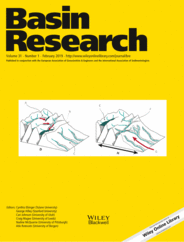
Full text loading...
 , Diego Montecino2, Verónica Oliveros1, Natalia Astudillo2, Paulina Vásquez2, Robinson Reyes1, Christopher Celis1, Rodrigo González3, Juan Contreras4, Christian Creixell2, Amancay Martínez5
, Diego Montecino2, Verónica Oliveros1, Natalia Astudillo2, Paulina Vásquez2, Robinson Reyes1, Christopher Celis1, Rodrigo González3, Juan Contreras4, Christian Creixell2, Amancay Martínez5
The geodynamic setting along the SW Gondwana margin during its early breakup (Triassic) remains poorly understood. Recent models calling for an uninterrupted subduction since Late Palaeozoic only slightly consider the geotectonic significance of coeval basins. The Domeyko Basin initiated as a rift basin during the Triassic being filled by sedimentary and volcanic deposits. Stratigraphic, sedimentological, and geochronological analyses are presented in order to determine the tectonostratigraphic evolution of this basin and to propose a tectonic model suitable for other SW Gondwana‐margin rift basins. The Domeyko Basin recorded two synrift stages. The Synrift I (~240–225 Ma) initiated the Sierra Exploradora sub‐basin, whereas the Synrift II (~217–200 Ma) reactivated this sub‐basin and originated small depocentres grouped in the Sierra de Varas sub‐basin. During the rift evolution, the sedimentary systems developed were largely controlled by the interplay between tectonics and volcanism through the accommodation/sediment supply ratio (A/S). High‐volcaniclastic depocentres record a net dominance of the syn‐eruptive period lacking rift‐climax sequences, whereas low‐volcaniclastic depocentres of the Sierra de Varas sub‐basin developed a complete rift cycle during the Synrift II stage. The architecture of the Domeyko Basin suggests a transtensional kinematic where N‐S master faults interacted with ~NW‐SE basement structures producing highly asymmetric releasing bends. We suggest that the early Domeyko Basin was a continental subduction‐related rift basin likely developed under an oblique convergence in a back‐arc setting. Subduction would have acted as a primary driving mechanism for the extension along the Gondwanan margin, unlike inland rift basins. Slab‐induced dynamic can strongly influence the tectonostratigraphic evolution of subduction‐related rift basins through controls in the localization and style of magmatism and faulting, settling the interplay between tectonics, volcanism, and sedimentation during the rifting.

Article metrics loading...

Full text loading...
References


Data & Media loading...
Supplements

